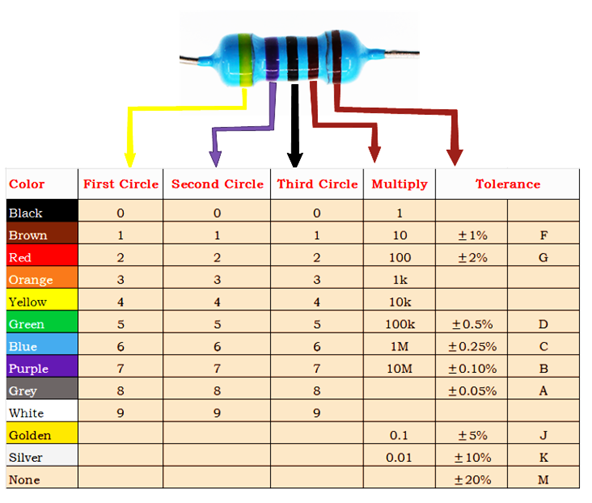😊New Customer Discounts😊All Order Get 5% Off.
Menu



In our latest blog “ DIY Electronic Alarm Clock Kits”, we have referred to color circle resistance soldering. You might know little about this resistance. So i decided to write a blog to help you enter into the world of basic electronic . Color circle resistance is a kind of resistance, which is widely used to various electronic devices. No matter how it installed, maintenance people can easily read out its value by color circle, thus enable them to check and replace it very conveniently. Normally there are four-color resistance, five-color resistance and six color resistance. Today we are going to teach you how to identify color circle resistance value. Before we move on, let’s take a look of the picture below: 
You might wonder how i read the value? Don’t worry. Go on read the passages below, you will learn the knack soon.
Firstly, let’s learn how to read color circles.
Four-color resistance: The first circle and second circle in four-color resistance relatively represent the former two numbers of resistance value, the third circle stands for magnification, and the fourth for tolerance. The key point to identify it quickly depends on the third color circle which limits the resistance value to a scale. For example, several decimal point K or tens K. You can place the number of the first and second circle showed into this format so that you can read the resistance value very quickly.
Five-color Resistance The former three color circle stand for valid numbers, the fourth circle for the Nth power of 10, and the fifth circle for tolerance.
Six-color Resistance: Readings of the former five circles are the same with five-color resistance, but the last circle stands for temperature index of resistance.
Now, you might know a little bit about how to read color circles but still not fully understand. Let me show you a case of four-color resistance and learn how to read these color circles better:
2. Try to remember the resistance scale of the third color circle.As for five-color or six-color resistance, you shall remember the resistance scale of the fourth circle. This is the key point to identify resistance value quickly. The following is the actual scale of each color
Golden several decimal point
Black Tens
Brown Hundreds
Red several decimal point k
Orange Tens k
Yellow Hundreds k
Green several decimal point M
Blue Tens M
According the magnitude , we can divide these colors into 3 levels for easier remembrance:
level: golden, black, brown;
K level: red, orange, yellow;
M green, blue.
3. When the second circle is black, the third circle stands for an integer. As for five-color or six-color resistance, it is the third or the fourth color circle relatively. The integer can be several, tens or hundreds K . This is a special case for reading. You have to pay more attention to it. For example, if the third circle is red, then the resistance value is integer tens K
4. The fourth color circle represent tolerance. As for five-color or six-color resistance, it is the fifth color circle. Here is the tolerance value of each color:
Golden: 5%;
Silver:10%;
None:20%.
Now, i think you must have a clearer idea about color circles. But you must have a question in your mind now: how to clarify color circle sequence?
Usually in practical usage, we find the color circle sequence of some resistance is not clear that we often read the wrong value. In order to identify it, i have made a conclusion of 3 methods. Hope these methods will be your help.
Method 1 Try to find the color circle stands for tolerance first, then we can know the sequence of color circle. Usually, golden, silver, brown(especially golden and silver)are the ordinary colors for tolerance. These colors are seldom used for the first circle of resistance. So we can judge it is the last circle of resistance only if we see golden circle or silver circle.
Method 2 Brown circle judgement. Brown circle is usually used to stand for tolerance as well as valid number. It often appears in the first circle and the last circle at the same time. So it is hard to recognize which one is the first circle. In practical usage, we can judge from the space between color circles. Take a five-color resistance for example. The space between fourth circle and fifth circle are comparatively wider than the space of the first and second circle. Thus we can know the sequence of color circles.
Method 3 If we can not know color circle sequence by circle space, we can judge from the sequence value of resistance. For example, there is a resistance with color circle sequence: brown, black, black, yellow, brown. And the value is 100X104 =1M , tolerance 1%.It belongs to normal resistance value. However, if we read in reverse, then the color sequence is brown, yellow, black, black, brown and the value becomes 140X1=140 tolerance 1%. Obviously, the value read out by the latter sequence of color reading is not existed in resistance production series. So the latter sequence of color reading is wrong.
The following is an example which illustrates this matter
Example
Resistance Value 10*1=510 Ω
Now, are you clear about how to read color circle resistance value? If you would like to know more about resistance, you can go on follow up our blogs or leave your comments to us. We will go on to teach you how to clarify chip resistance. For more interesting and useful blogs, please see our website: www.elecfreaks.com.
Stay up-to-date with our latest promotions,discounts,sales,and special offers.